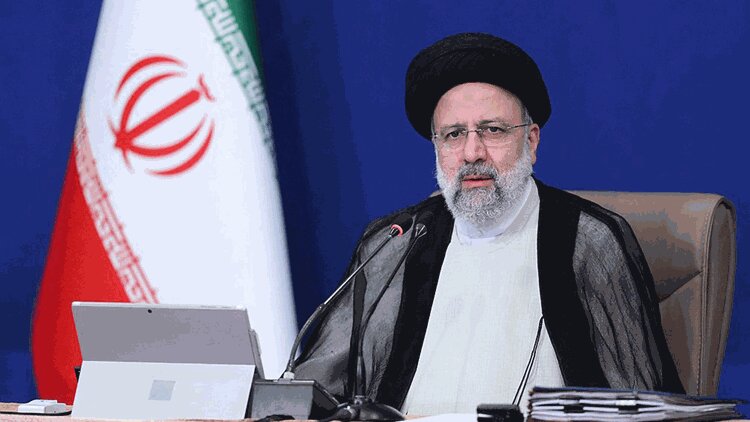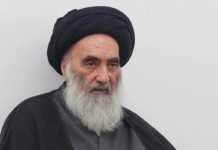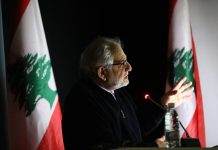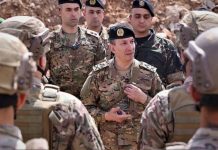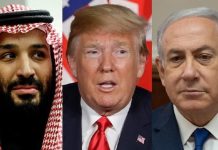Iran Garnering Internal Support for a Potential Nuclear Deal
Omer Carmi/The Washington Institute/August 23/2022
إيران تحشد الدعم الداخلي للتوصل إلى اتفاق نووي محتمل
عومير كرمي/معهد واشنطن/23 آب/2022
على الرغم من أنه لا يزال من غير الواضح ما إذا كان المرشد الأعلى سيوافق على قبول حلول توافقية ضرورية للتوصل إلى اتفاق نووي، إلا أن مسؤولي النظام الإيراني يزيدون إلى الحد الأقصى من مساحة المناورة المتوفرة لديهم، من خلال إعداد البلاد لكلتا الحالتين – على افتراض أن الاقتصاد لا يجبرهم على ذلك.
منذ أن تولى الرئيس إبراهيم رئيسي منصبه العام الماضي، دأبت إيران على عدم إعطاء الأولوية بشكل مطرد لأهمية العودة إلى «خطة العمل الشاملة المشتركة»، ومع ذلك فقد تغير خطابها بشأن هذه المسألة بعدة طرق ملحوظة خلال الأسبوع الماضي. فمع اقتراب المفاوضين من مفترق طرق آخر في المحادثات النووية، وسط تقارير عن “مسودة نهائية” وزعها المسؤولون الأوروبيون، يبدو أن النظام الإيراني يُعِدّ كوادره والجمهور الأوسع نطاقاً لقبول حل توافقي إذا أصبحت ضرورية من الناحية السياسية أو الاقتصادية، سواء بشكل وشيك أو في المستقبل.
النشاط الأخير يشير إلى البناء المألوف على التوافق في الآراء
يبدو أن المسؤولين الإيرانيين يتبعون قواعد اللعبة التي وُضعت في عام 1988، عندما تعيّنَ على النظام أن يجد طريقة للخروج من حرب طويلة ومدمرة مع العراق على الرغم من إعلانه مراراً وتكراراً أنه سيقاتل حتى النهاية المريرة. ففي ذلك الوقت، كما هو الحال الآن، تمثّلَ الهدف في بناء إجماع داخلي، استناداً إلى الاعتقاد بأنه حتى النظام الاستبدادي مثل الجمهورية الإسلامية يحتاج إلى استثمار درجة معينة من الوقت والموارد في تبرير سياساته محلياً. وعلى الرغم من أن المفاوضات النووية الحالية لا تتسم بالدراماتيكية نفسها مثل ذلك الوقت المحوري، إلّا أنه يمكن ملاحظة الكثير من الآليات نفسها.
على سبيل المثال، خلال مؤتمر صحفي عُقد في 15 آب/أغسطس، صرّح وزير الخارجية حسين أمير عبد اللهيان أنه إذا أبدت الولايات المتحدة مرونة كافية فيما يخص تعليقات إيران على مسودة الاتفاقية التي طرحها “الاتحاد الأوروبي”، فسيتم التوصل إلى اتفاق في غضون أيام قليلة. وردّ أيضاً على الانتقادات المحلية للمسودة، موضحاً أنه بينما كان ممثلو “مجلس الشورى الإسلامي” على حق في الإشارة إلى شوائبها المفترَضة، كان عليهم التذكُّر أن المفاوضات تستلزم أخذ اعتبارات الطرف الآخر ومطالبه في الاعتبار. وفي وقتٍ لاحقٍ من ذلك اليوم، ترأّسَ الرئيس رئيسي اجتماعاً خاصاً عقدَه “المجلس الأعلى للأمن القومي” لمناقشة رد إيران الرسمي على المسودة، والذي تم إرساله بعد ساعات قليلة.
وفي 16 آب/أغسطس، استمع أعضاء “لجنة الأمن القومي” في “مجلس الشورى الإسلامي” إلى إحاطة قدّمها أمير عبد اللهيان، وأمين “المجلس الأعلى للأمن القومي” علي شمخاني، وكبير المفاوضين النوويين علي باقري كني، ورئيس “منظمة الطاقة الذرية” محمد إسلامي. ووفقاً لوكالة “نور نيوز” الإعلامية التابعة لـ”المجلس الأعلى للأمن القومي”، قال شمخاني للممثلين إن النظام لن يتراجع عن خطوطه الحمراء النووية. واستمرت الحملة لحشد الدعم البرلماني في اليوم التالي عندما حضر مسؤولو النظام الأربعة نفسهم اجتماعاً مغلقاً عقده “مجلس الشورى الإسلامي”. وعلى الرغم من تقديم إحاطات مماثلة في وقتٍ سابقٍ من هذا العام عندما أفادت بعض التقارير أن الاتفاق كان وشيكاً، إلّا أن وجود جميع المسؤولين الأربعة على أرض “المجلس” كان أمراً غير معتاد. وفي موازاة ذلك، استخدم كبار المسؤولين وسائل الإعلام لبناء توافُق داخلي أيضاً، حيث أفادت بعض التقارير أن باقري كني كان يطلع الصحفيين البارزين على شروط الاتفاق الناشئ.
وتعكس جميع هذه الجهود النشاط الموثق في مذكرات الراحل أكبر هاشمي رفسنجاني، الذي ساعد في قيادة المجهود الحربي في عام 1988، بينما كان يبذل في الوقت نفسه كل ما في وسعه لإنهائه. فوفقاً لما دوّنه في مذكراته اليومية، سعى إلى إقناع بقية القيادة بأن إيران كانت في حالة يُرثى لها ولم يَعُد بإمكانها تحمُّل استمرار النزاع، وذلك بالتعاون مع الرئيس آنذاك (الذي كان سيصبح المرشد الأعلى في موعد قريب) علي خامنئي لإحاطة “مجلس الشورى الإسلامي” والقوات المسلحة ومختلف مجالس النظام وجمعياته بشكل مكثف. وقد عمما الرسالة نفسها على مسؤولي النظام من الرتبة المتوسطة والجمهور الأوسع نطاقاً، من خلال إصدارهما تعليمات للأئمة بنشر السردية الجديدة في خُطَب صلاة الجمعة، وعَقدهما مؤتمرات صحفية لشرح المنطق الذي يكمن خلف اتباع هذه السياسة، وتنسيقهما الجهود الإعلامية لتصوير نتيجة الحرب على أنها انتصار إيراني.
وفي النهاية، وعلى الرغم من خطر رد الفعل العنيف من قبل أنصار النظام الأكثر تشدداً، قرر المرشد الأعلى روح الله الخميني تجرُّع ما يسمى بـ”الكأس المُرّة” من خلال تأييد التسوية من أجل بقاء النظام، بينما تمكّنَ رفسنجاني وخامنئي من تشتيت الاعتراض المحلي على القرار. واستخدمت طهران أسلوب العمل نفسه عندما برزت حاجة للتوصل إلى حلول وسط خلال المفاوضات النووية التي جرت في عامَي 2003 و2015.
ما الذي يقوله النظام للإيرانيين حالياً؟
تُركّز رسائل طهران الأخيرة على ثلاث نقاط رئيسية. أولاً، تُشدد على أنه في حين أن الصفقة هي في متناول اليد، إلّا أن الكرة الآن في الساحة الأمريكية، وعلى واشنطن تقديم المزيد من التنازلات. وفي 15 آب/أغسطس، قال متحدث باسم وزارة الخارجية الإيرانية إن مسودة الاتفاقية الأوروبية لا تلبي مطالب إيران حتى الآن، على الرغم من التقدم النسبي الذي أحرزه الطرفان، كما أكدت “وكالة أنباء الجمهورية الإسلامية” (“إيرنا”) مراراً أن على واشنطن اتخاذ القرارات السياسية اللازمة. وكرر أمير عبد اللهيان هذه الرسالة، مشيراً إلى أنه على الولايات المتحدة أن تتنازل وتُقدّم ضمانات بأن الصفقة ستستمر. وقدّمت الصحف المتشددة حججاً مماثلة. وأكّد مقالٌ نُشر في 17 آب/أغسطس في صحيفة “جافان” أن طهران جعلت من الصعب على واشنطن رفض الاتفاق. وشددت صحيفة “كيهان” مراراً وتكراراً على أن اتفاقاً دون تخفيف حقيقي للعقوبات الأمريكية وضمانات تقدّمها الولايات المتحدة من شأنه أن يُلحق الضرر مجدداً بإيران، وحثّت الحكومة على تذكُّر أن عدم التوصل إلى اتفاق أفضل من وجود اتفاق سيئ. وربما تُشكّل هذه الرسائل طريقة يعتمدها النظام للاحتراز من الانتقادات المستقبلية المحتملة من العناصر المحلية التي دفعت باتجاه اتباع استراتيجية أكثر واقعية للتفاوُض. وفي الواقع، أكد الرئيس السابق حسن روحاني الشهر الماضي أنه كان من الممكن إحياء «خطة العمل الشاملة المشتركة» خلال فترة ولايته لو لم يوافق “مجلس الشورى الإسلامي” على قانون في كانون الأول/ديسمبر 2020 الذي طالبَ الحكومة بتقليص التزاماتها بموجب الاتفاقية.
ثانياً، يشيد المسؤولون المحافظون ووسائل الإعلام المحافظة بالمفاوضين (وبالتالي بحكومة رئيسي)، في محاولة واضحة لتفادي توجيه أي انتقادات متشددة في المستقبل لدوافع الفريق أو أدائه – وهو اختلاف صارخ عن المعاملة التي تلقتها دائرة روحاني. ففي 12 آب/أغسطس، وصف الإمام الذي أقامَ صلاة الجمعة في طهران المفاوضين بأنهم “فريق متمرس وثوري ومحفَّز”. وعلى نحو مماثل، أشار الرئيس رئيسي في 21 آب/أغسطس إلى أن إيران حصلت على “جزء كبير من مطالبها” من خلال “نهجها المشرّف”. وحتى أن صحيفة “كيهان” – التي غالباً ما تنتقد المحادثات النووية – أشارت في 15 آب/أغسطس إلى أن المفاوضين حرصوا على الإصرار على مبادئ إيران ومصالحها، مضيفةً أن الصفقة الحالية أقوى بكثير من تلك التي تساومت عليها حكومة روحاني. ومن المؤكد أن الصحيفة أوضحت أيضاً أن المسودة الأخيرة لا تزال غير مقبولة. ومع ذلك، ربما كان تأييدها للفريق المفاوض بمثابة إشارة موجهة إلى القراء المحافظين والمتشددين، وذلك لدعم مواصلة المفاوضات حتى لو لم يتم التوصل إلى اتفاق في الأيام المقبلة.
ثالثاً، كما في الماضي، يقول مسؤولو النظام إن الاتفاق ليس أمراً إلزامياً بالنسبة لإيران وأن البلاد لديها “خطة بديلة”، كما أشار حسين عبد اللهيان في 15 آب/أغسطس. وبالمثل، قام نائبه مهدي سفاري – المسؤول عن الدبلوماسية الاقتصادية في وزارة الخارجية الإيرانية وشغل سابقاً منصب سفير لدى روسيا والصين – بإخبار صحيفة “اعتماد” الإصلاحية أن “العقوبات لا تعادل الموت”. وفي 18 آب/أغسطس، روّجت الصفحة الأولى من صحيفة “جام إي جام” المحافِظة التي يملكها النظام للحجة المتمثلة في أن دبلوماسية رئيسي النشطة قد تلافت العقوبات بنجاح. وبعد ثلاثة أيام، أشادت صحيفة “إيران” التابعة للنظام بـ “دبلوماسية الطاقة النشطة” التي تنتهجها الحكومة. وفي 22 آب/أغسطس، قال متحدث باسم وزارة الخارجية إن الغرب يحتاج إلى التوصل إلى اتفاق أكثر من إيران، ثم أعلن أن النظام سيتابع مسار سياسته الخارجية الحالية إذا لم يتم التوصل إلى اتفاق. وأثنت صحيفة “كيهان” على هذه الحجة، فزعمت أن إيران هي في “موقع متفوق” لأن واشنطن وأوروبا هما في أمس الحاجة إلى نفطها.
وفيما يتعلق بما قد تنطوي عليه “الخطة البديلة” على وجه التحديد من الناحية العملية، حذّر الممثل البارز لـ”مجلس الشورى الإسلامي” إسماعيل كوثري في 16 آب/أغسطس من أن إيران ستزيد قدرتها على تخصيب اليورانيوم إلى 190 ألف وحدة عمل فصل إذا لزم الأمر. (للحصول على شرح لهذه النقطة والمفاهيم التقنية الأخرى، من بينها الزمن المحتمل لطهران لتجاوز العتبة النووية، راجع المقالين تفسير التطور النووي الإيراني وإيران النووية – قائمة مصطلحات المنشورين من قبل معهد واشنطن).
الطريق إلى المستقبل
على الرغم من أن المرشد الأعلى خامنئي لم يتحدث عن المفاوضات النووية منذ أسابيع، إلّا أنه يُفترض أن هذا ليس إلا التكتيك الذي يتبعه عادةً لعزل نفسه عن التعرض للّوم إذا نشأ خلاف – سواء من خلال تقديم تنازلات أو تجنب عقد اتفاق سريع. وفي جميع الاحتمالات، فإنه [الزعيم] الذي يتولى تنسيق كافة القرارات والتوجيهات النووية الصادرة عن “المجلس الأعلى للأمن القومي” ويوافق عليها. وفي الوقت الحالي، لم يتضح بعد ما إذا كان مستعداً لتقديم المزيد من التنازلات، أو يفضّل الاستمرار في التخلي عن مزايا «خطة العمل الشاملة المشتركة» على المدى القريب.
ومن خلال تهيئة الجمهور لمجموعة واسعة من البدائل، فإن رسائل طهران الحالية قد تُمكّن خامنئي من تأجيل القرار إذا رغب في ذلك. إلا أن هذه الاستراتيجية قد تُسبب نتائج عكسية أيضاً، نظراً إلى الوضع العسير الذي يعاني منه أساساً الاقتصاد الإيراني. وقد أدى التفاؤل الأخير بشأن مصير «خطة العمل الشاملة المشتركة» إلى تحسين سعر صرف الريال مقابل الدولار، لكن الفشل في التوصل إلى اتفاق (أو على الأقل الحفاظ على المحادثات) قد يُقحم الأسواق الإيرانية في حلقة مفرغة أخرى.
*عومير كرمي هو زميل زائر سابق في معهد واشنطن.
Iran Garnering Internal Support for a Potential Nuclear Deal
Omer Carmi/The Washington Institute/August 23/2022
Although it is still unclear if the Supreme Leader will approve the necessary compromises, regime officials are maximizing their room for maneuver by preparing the country either way—assuming the economy doesn’t force their hand.
Since President Ebrahim Raisi took office last year, Iran has been steadily deprioritizing the importance of returning to the Joint Comprehensive Plan of Action (JCPOA), yet its rhetoric on the matter has shifted in several notable ways over the past week. As negotiators approach another crossroads in the nuclear talks amid reports of a “final draft” circulated by European officials, the regime appears to be preparing its cadres and the wider public for accepting compromise if it becomes politically or economically necessary, whether imminently or down the road.
Latest Activity Points to Familiar Consensus Building
Iranian officials are seemingly following a playbook established in 1988, when the regime had to figure a way out of a long, destructive war with Iraq despite repeatedly declaring that it would fight to the bitter end. Then as now, the goal was to build internal consensus, based on the belief that even an authoritarian system like the Islamic Republic needed to invest some degree of time and resources in justifying its policies domestically. Although the current nuclear negotiations are not as dramatic as that pivotal moment, many of the same mechanisms are evident.
For example, during an August 15 press conference, Foreign Minister Hossein Amir-Abdollahian stated that if the United States showed sufficient flexibility regarding Iran’s comments on the draft agreement floated by the European Union, a deal would be reached in a few days. He also responded to domestic criticism of the draft, explaining that while Majlis representatives were right to point out its supposed flaws, they needed to remember that negotiations entail taking the other side’s considerations and demands into account. Later that day, President Raisi chaired a special Supreme National Security Council (SNSC) meeting to discuss Iran’s official response to the draft, which was sent a few hours afterward.
On August 16, members of the Majlis National Security Committee were briefed by Amir-Abdollahian, SNSC secretary Ali Shamkhani, head nuclear negotiator Ali Bagheri Kani, and Atomic Energy Organization chief Mohammad Eslami. According to the SNSC-affiliated media outlet Nour News, Shamkhani told the representatives that the regime will not retreat from its nuclear redlines. The campaign to garner parliamentary support continued the following day when the same four regime officials attended a closed-door Majlis meeting. Although similar briefings took place earlier this year when a deal was reportedly imminent, the presence of all four officials on the Majlis floor was unusual. In parallel, senior officials have been using media outlets to build internal consensus as well, with Bagheri Kani reportedly briefing prominent journalists about the terms of the emerging deal.
All of these efforts echo the activity documented in the memoirs of the late Akbar Hashemi Rafsanjani, who helped command the war effort in 1988 while simultaneously doing everything he could to end it. According to his diary entries, he sought to convince the rest of the leadership that Iran was in dire straits and could no longer afford to continue the conflict, partnering with then-president (and soon-to-be Supreme Leader) Ali Khamenei to intensively brief the Majlis, the armed forces, and various regime councils and assemblies. They spread the same message to mid-tier regime officials and the broader public, instructing imams to propagate the new narrative in Friday prayer sermons, holding press conferences to explain the logic behind the policy, and coordinating a media effort to portray the war’s outcome as an Iranian victory.
In the end, and despite the risk of backlash from the regime’s most zealously hardline supporters, Supreme Leader Ruhollah Khomeini decided to drink the so-called “poison chalice” by endorsing compromise for the sake of regime survival, while Rafsanjani and Khamenei managed to deflect domestic opposition to the decision. Tehran employed the same modus operandi when compromises were needed during the nuclear negotiations of 2003 and 2015.
What Is the Regime Telling Iranians Today?
Tehran’s latest messaging is focused on three main points. First, it emphasizes that while a deal is within reach, the ball is now in America’s court, and Washington needs to make further compromises. On August 15, a Foreign Ministry spokesman argued that the European draft agreement does not yet meet Iran’s demands despite the relative progress the parties have made, and the Islamic Republic News Agency (IRNA) repeatedly asserted that Washington must make the necessary political decisions. Amir-Abdollahian reiterated this message, noting that the United States must compromise and provide guarantees that the deal will last. Hardline newspapers have made similar arguments. An August 17 article in Javan asserted that Tehran has made it difficult for Washington to say no to the deal. And Kayhan has repeatedly emphasized that an agreement without real U.S. sanctions relief and guarantees would once again bring harm to Iran, urging the government to remember that no deal is better than a bad one. Such messaging may be the regime’s way of hedging against potential future criticism from domestic elements who have pushed for a more pragmatic negotiating strategy. Indeed, former president Hassan Rouhani asserted last month that the JCPOA could have been revived during his tenure if the Majlis had not approved the December 2020 act requiring the government to reduce its commitments under the agreement.
Second, conservative officials and media outlets are praising the negotiators (and, by extension, Raisi’s government) in an apparent bid to deflect any future hardline criticism of the team’s motivation or performance—a stark difference from the treatment Rouhani’s circle received. On August 12, the imam who delivered the Friday prayer service in Tehran called the negotiators an “experienced, revolutionary, and motivated team.” Similarly, President Raisi noted on August 21 that Iran has received a “significant part of its demands” through its “honorable approach.” Even Kayhan—which often lashes out at the nuclear talks—noted on August 15 that negotiators have been careful to insist on Iran’s principles and interests, adding that the current deal is much stronger than the one bargained by Rouhani’s government. To be sure, the newspaper also made clear that the latest draft is still unacceptable. Yet its endorsement of the negotiating team may have been a signal directed at conservative and hardline readers, building the case to continue the negotiations even if no deal is achieved in the coming days.
Third, as in the past, regime officials have been saying that a deal is not a must for Iran and that the country has a “Plan B,” as Hossein-Abdollahian put it on August 15. His deputy Mehdi Safari—who covers economic diplomacy at the Foreign Ministry and previously served as ambassador to Russia and China—likewise told reformist newspaper Etemad that “sanctions are not equivalent to death.” On August 18, the front page of regime-owned conservative newspaper Jam-e Jam touted the argument that Raisi’s active diplomacy has successfully bypassed sanctions. Three days later, the regime newspaper Iran praised the government’s “active energy diplomacy.” And earlier today, a Foreign Ministry spokesman argued that the West needs a deal more than Iran, then declared that the regime would continue its current foreign policy trajectory if no agreement is reached. Kayhan doubled down on this argument, claiming that Iran is in a “superior position” because Washington and Europe are in dire need of its oil.
As for what exactly “Plan B” might entail in practice, prominent Majlis representative Esmail Kowsari warned on August 16 that Iran will increase its uranium enrichment capacity to 190,000 separative work units if need be. (For an explanation of this and other technical concepts, including Tehran’s potential breakout time, see The Washington Institute’s Iran Nuclear Explainer and Nuclear Glossary.)
The Road Ahead
Although Supreme Leader Khamenei has not spoken about the nuclear negotiations for weeks now, this is presumably just his usual tactic of insulating himself from blame if controversy ensues—whether from making compromises or eschewing a quick deal. In all likelihood, every nuclear decision and directive made by the SNSC is being coordinated and approved by him. And for the time being, it remains unclear whether he is willing to make further compromises or prefers to keep foregoing the JCPOA’s benefits in the near term.
By preparing the public for a wide set of alternatives, Tehran’s current messaging could enable Khamenei to postpone the decision if he so desires. Yet this strategy might also backfire given the already worn-out state of Iran’s economy. Recent optimism about the fate of the JCPOA has improved the rial’s exchange rate versus the dollar, but failure to reach a deal (or, at least, maintain the talks) could send Iranian markets into yet another downward spiral.
















